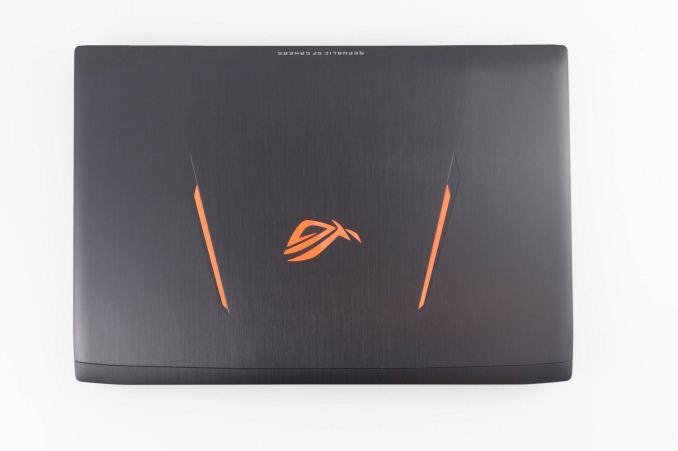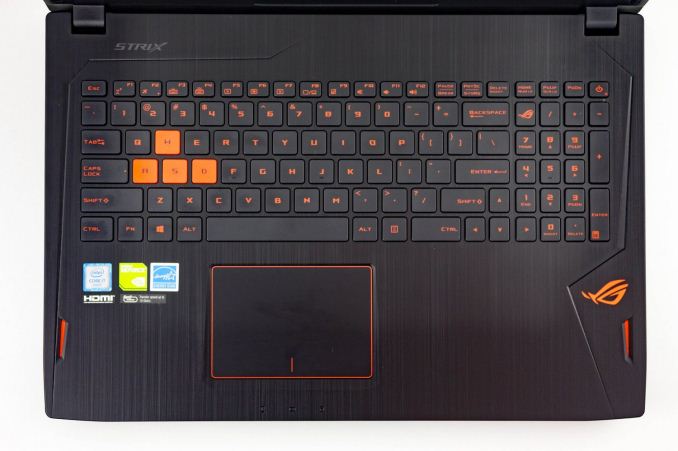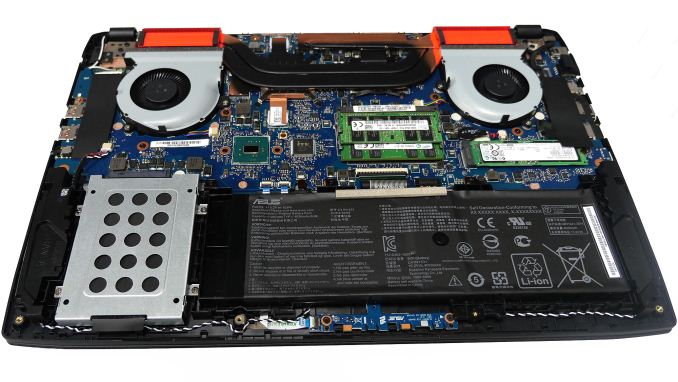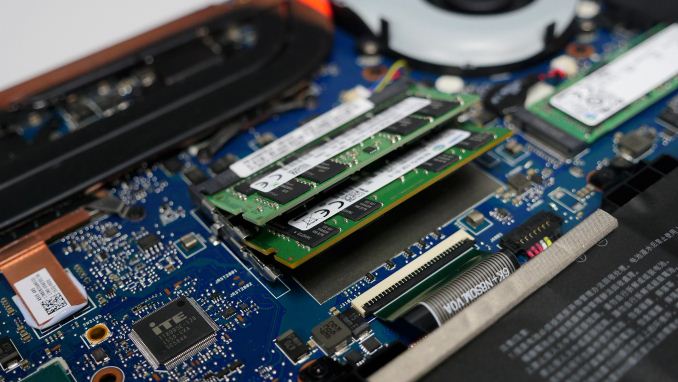The ASUS ROG Strix GL502VS Review: Mainstream GTX 1070 with G-SYNC
by Brett Howse on December 9, 2016 8:00 AM ESTDesign
Without putting too fine a point on it, ASUS can design some stunning notebooks, but this is not one of them. Stepping down to their value line keeps the same powerful internals, but to hit this price point ASUS has taken some liberties with the chassis design. The entire notebook is built from a fairly low quality plastic, with the exception of the lid which has a metal top. The top has a brushed finish with lines running parallel down the entire device, which looks nice, but that’s where the premium materials end.
Opening the notebook, the same brushed finish is replicated on the plastic keyboard deck, but this time on the plastic finish. The keyboard itself features 1.6 mm of travel with red backlighting, but the keyboard feel lacks the nice feel of some of the other ASUS notebooks. The WASD keys are red with black fonts, compared to the rest of the keys which are black with red fonts, and although the look won’t appeal to everyone, it does help quickly identify the most needed keys for gaming. ASUS continues its silly tradition of having the power key right in the keyboard, with it at the top right. If you accidently go to press the minus key, you may end up shutting off the laptop. There’s no good reason for them to put it there, although at least on this notebook, with its extra number pad, it is less likely to get hit than on one of their smaller notebooks where it is right beside the delete key. This seems like a small gripe, but shutting off your computer when going to hit a key is not a great experience.
The trackpad on this notebook does feature the Microsoft Precision Touchpad drivers, for better or for worse, and it’s nice to see Microsoft reigning this in. They still have some work to do with the drivers, but at least it is a consistent experience across devices now. That being said, the trackpad on this notebook is not quite as smooth as some other notebooks, and picks up fingerprints quite readily. It would be nice to see a glass trackpad, although once again the budget comes into play. Luckily a good mouse is going to be required for gaming regardless, so this isn’t as big of an issue as it is on a more portable device.
Being a large gaming laptop, there is expandability with the GL502VS, and just a couple of screws will let you pop off the bottom and access the memory, which has two SODIMM slots, the M.2 SSD, and the SATA drive. Maximum memory is 32 GB through two 16 GB DDR4 modules. On our 16GB sample, only one memory slot was occupied for single channel memory performance.
Interior photos courtesy of rog.asus.com
Overall the design of the ASUS GL502VS is kind of disappointing. The top of the notebook is a very nice looking metal, but the remainder of the notebook is a fairly low grade plastic. ASUS does build some nice notebooks, but to hit their budget on this one with the components on the inside, clearly some cost cutting was necessary. They have also gone a bit overboard with the red accents on this notebook, and especially with the bright shade of red chosen, although the almost orange WASD keys do look nice and red with the keyboard backlighting on.

















54 Comments
View All Comments
sundragon - Thursday, January 12, 2017 - link
There isn't a 4K screen offered on the GL502VS. I agree with you on the keyboard color, the orange is nice but it can be a bit much.Ethos Evoss - Friday, January 6, 2017 - link
Why they still bothering with HDDs ??! they should stop it and put rather bigger battery !sundragon - Thursday, January 12, 2017 - link
I have 6 games on mine and it's taking up over 200GB of space. The 1TB HDD is perfectly fine performance wise vs paying more for a 1TB SSD. The battery is of little consequence on a 1070 equipped laptop with G-Sync. The GPU is so hungry that even a larger battery will make very little difference in overall battery life.danwat1234 - Wednesday, April 19, 2017 - link
https://rog.asus.com/forum/showthread.php?88253-GL...Amazing. MSI tried to pull this stunt with "NOS" , where it would drain the battery because they used a 180w AC adapter on a 980m GT72 or whatever laptop.
Alienware doesn't borrow battery power AFAIK but would throttle with the 180w adapter and they soon offered a free ~240w replacement.
Now Asus.
What is wrong with laptop manufactures. MSI and Alienware didn't get away with it, why did Asus think they could?
Some people use their gaming laptops for work that uses the CPU cores and GPU cores for days at a time at full load.
Curious if the 180w 6700HQ 1070 Asus laptops can have that corrected with a firmware update possibly to overdraw from the adapter/accept a ~240w one? Or maybe just throttle, which really doesn't help things.